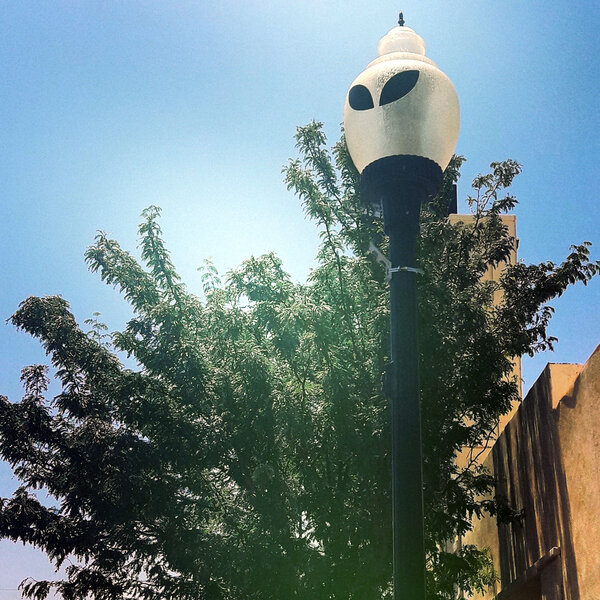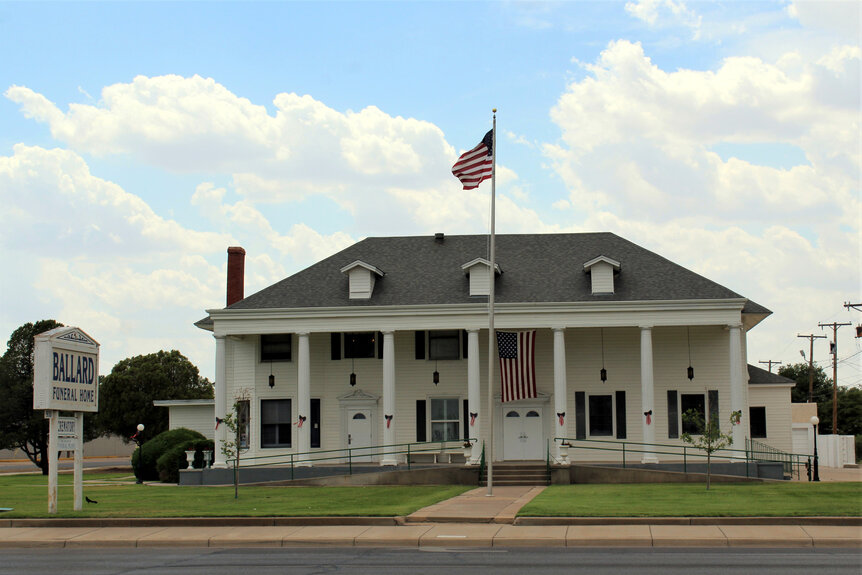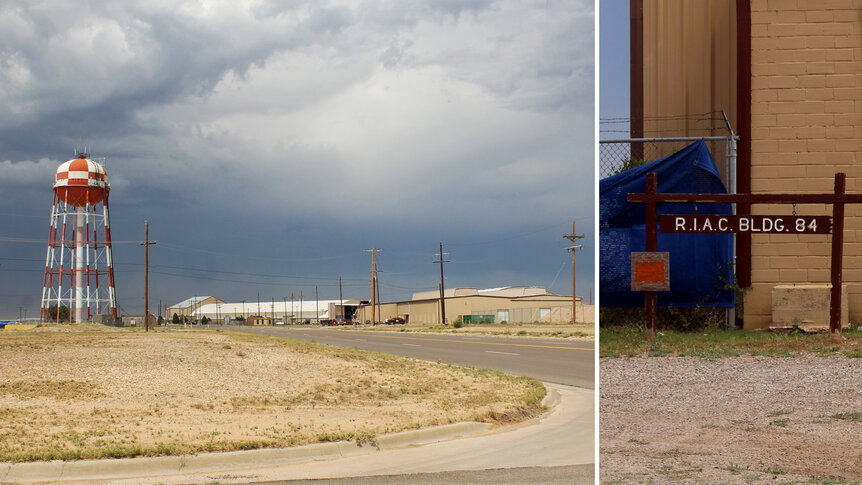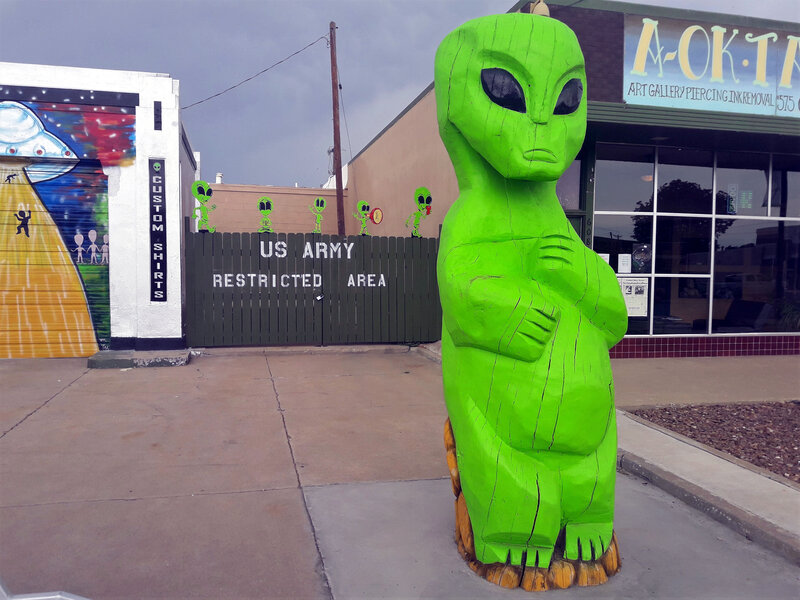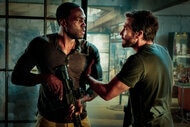Create a free profile to get unlimited access to exclusive videos, sweepstakes, and more!
Geek Road Trip: A private tour of Roswell with a UFO expert looking for the truth
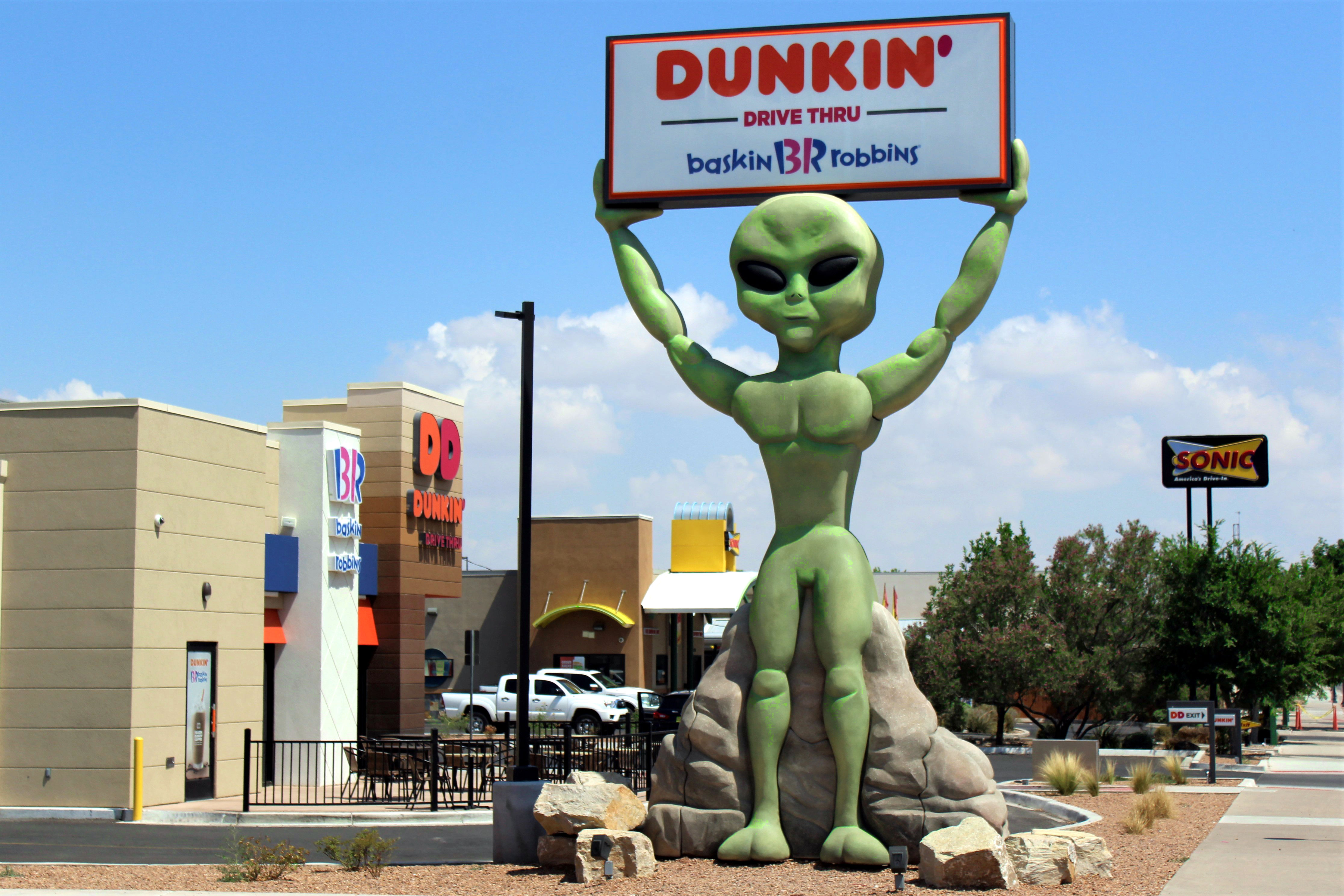
The city of Roswell, New Mexico, knows exactly why you're here. From the International UFO Museum and Research Center to the enormous "little green man" holding up a Dunkin' Donuts sign to the alien-faced streetlights along downtown's main drag, the city embraces its notoriety and novelty in a way that few other places have. Even its official motto, "We Believe," all but admits to the veracity of the infamous "Roswell UFO Incident" of 1947, when a flying saucer was alleged to have crash-landed in the desert beyond the city limits before the government promptly covered it up.
Or, at least, that's what Roswell wants you to think that it thinks.
To hear author and UFO researcher Dennis Balthaser tell it, the tourist campaign and the gift shops are all a sleight of hand, an illusion, a way to keep folks from looking too deeply at the truth. The city, he says, is more interested in selling T-shirts than preserving history. He refers to the recent UFO Festival — an annual parade, costume contest, and concert, this year headlined by Billy Ray Cyrus — as a "circus," all spectacle and no substance.
Balthaser doesn't have time for a show — he, like so many of us, is after the truth.
I meet Balthaser in an otherwise empty parking lot. He's an older, unassuming man, standing in the shade of a tree and leaning against the hood of his SUV. His white cowboy hat is pulled low as he waits for me. He greets me with a nod, extends his hand.
He started offering tours of Roswell a few years ago, as a counter to the growing commercialization of the city's history, with the expectation of running three, maybe four a month. His current schedule is 10 tours a week, and he books up fast. I'm not even the first tourist he's picked up today.
We start with the conspiracy right away: The first stop is the offices of the Roswell Daily Record, the newspaper that published the first report of a downed UFO, and then, the very next day, published the retraction. He tells the tale of the rancher, Mack Brazel, who found the debris in the desert outside the city proper, then brought it to Roswell's sheriff. Brazel, I'm told, had a profitable side hustle turning in downed weather balloons for a reward — he knew what one looked like. This, obviously, wasn't that. The sheriff, George Wilcox, didn't know what he was looking at either, so he called the military. Then the lawman got threatened. The rancher ended up in jail for five days. The military confiscated the debris.
Balthaser and I are sitting in a parking lot across the street from the Record as he recounts the story, the two of us eyeing the newspaper building like spies on a stakeout. He pulls out a binder, with reproductions of both front pages – the one about the Roswell Army Air Force "capturing" a flying saucer, and the one about the weather balloon.
"Twelve hours and the whole story changes." He lowers his sunglasses at me, raises an eyebrow. "That's a little suspicious, don't you think?"
After a detour through the residential parts of Roswell, past homes that once housed key players in the crash and its cover-up, we end up in another parking lot, near a statue of Sheriff Pat Garrett, the man who shot Billy the Kid — a different sheriff from a different town. He points to the Chaves County Courthouse annex across the street.
That was the sheriff's office in 1947, he tells me. Sheriff Wilcox lived there with his family; his wife cooked for the prisoners. That was where Brazel brought the debris. The material was strange — a metal that could be crushed but would reform after a few seconds — and Wilcox let his daughters play with it. "Extraterrestrial" hadn't entered the equation yet.
The air in the SUV changes then, and Balthaser's voice gets lower, slower. After handing the debris over to the Army, he tells me, the military police showed up and threatened the little girls.
"I've never forgiven them for that," he says.
He goes on to explain that the sheriff's office was demolished sometime around the 50th anniversary of the crash, when scrutiny of the event was once again growing. There's not even a sign that it was there, he tells me. No plaque in the new courthouse commemorating the history, one of the oldest buildings in the city.
He tilts his sunglasses again. Doesn't make a lot of sense, does it? Almost like they want the sheriff's office to be forgotten.
We drive down Main Street for a few minutes, then pull up in another parking lot, this one across from a funeral home. Balthaser tells me the story of Glenn Dennis, a mortician, one of the founders of the UFO museum and a good friend of his. They'd worked together at the museum for years.
Dennis was also the best civilian witness to the 1947 incident.
As the story goes, Dennis had given a ride to a soldier injured in a motorcycle accident, bringing him to the military hospital on the airfield. There he saw hunks of metal being loaded into ambulances, by military personnel he didn't recognize. Before he could turn his car around, he was threatened by a red-haired captain: If Dennis said anything, well, "they'll never find your bones in the desert."
The next day, Dennis received a call from the military hospital, inquiring about embalming fluids and child-sized coffins. Soon after that, a nurse he knew from the hospital was reported to have been relocated, and then, according to Dennis, to have died.
Balthaser doesn't know if that's entirely accurate. For one thing, there's no record of the crash that killed the woman. For another, he's pretty sure the mortician was having an affair with the nurse — he talked about how pretty she was, a lot, even 50 years later — and probably lied to protect her.
That's the problem with most witnesses, he tells me, shifting the car into gear, they lie, or they embellish, or they don't talk at all. There's something like frustration in his voice. He shakes his head. "You don't threaten people over weather balloons."
We drive another seven miles, along an ever-dwindling Main Street, the pomp and camp of downtown disappearing in the rearview. Eventually, we reach another development, replete with trees and grass and what is obviously former military housing. With a nod to the Roswell P.D. officer in the patrol car idling at the intersection there, Balthaser drives us inside the Roswell Air Industrial Park — previously the Roswell Army Airfield, where most of the incident actually occurred.
Our first stop is a large house at the end of a cul-de-sac — the one-time home of Colonel William H. Blanchard, the guy who put the kibosh on the original press release. He was a four-star general by the age of 50, Balthaser tells me, and an assistant to the Joint Chiefs of Staff, which was — and remains — practically unheard of for someone so young. Despite this meteoric rise and a subsequent move to the Pentagon, Blanchard still sent a Christmas card to Walter Haut — the retired public information officer who wrote the original, and then corrected, press releases — for 20 years, until Blanchard's death, never missing a holiday.
"Do you know why?" he asks me.
I don't, but I consider it might have been his way of thanking Haut for controlling what could have been an extremely embarrassing affair for the military man.
Balthaser smirks. "I think it was his way of telling Walt, 'I know where you live.'"
We head deeper into the industrial park, toward the airfield, the hangars. The tarmac is bustling with silver and white airplanes, stripped of all identifying marks. The buildings that were once so integral to both the incident and World War II are now home to a company that tears apart commercial airliners and sends away the components to be recycled into soda cans.
There's a metaphor here.
Balthaser stops before an empty patch of dirt, a few pieces of foundation barely visible now beneath the encroaching scrub grass. This used to be the hospital, he explains, where the bodies were brought after the crash. Where a nurse positively identified them as alien. Where Dennis was threatened. The city knocked the building down a few years ago, because someone had purchased it for development.
"That look developed to you?" he asks.
A few more turns and we're parked outside Hangar 84, where the debris from the crash was stored until it could be sent elsewhere. We get out of the SUV, the engine idling. I can't see anything except the arched roof; a tarped fence stretches between buildings, blocks most of my view. Balthaser points out the checked water tower behind us, a few blocks distant, one of the few relics still standing. One of the only pieces of the incident not to be paved over and repurposed.
As we're driving back into Roswell proper, Balthaser points out one of the ubiquitous carved wooden aliens that adorn the city's street corners and storefronts — all of them painted bright green, just like the city's logo and the T-shirts and the Dunkin' Donuts statue.
"They weren't green," he grumbles, and not for the first time.
Mack Brazel, the rancher harassed by the military, when he stumbled out of his prison cell after five long days, said as much — and he never said anything about the incident. Walter Haut and Glenn Dennis' nurse friend concurred: The alien bodies were grey. Three independent eyewitnesses all in agreement, the closest thing the Roswell Incident has to an ironclad fact.
But the city can't even get that right.
I didn't come to Roswell to be convinced of a vast and ongoing government conspiracy, nor was it Balthaser's stated goal — he just wants to know what rattled his friends so bad, so many years ago, what kept them scared to their very deathbeds. But, as I walk to my car, a storm brewing on the horizon, I have to admit: A city branding itself after an extraterrestrial incident while systematically erasing all evidence thereof is a little weird.
The truth, as they say, is out there, even if no one really knows what to look for.
And maybe Dennis Balthaser is the man to figure it out.
And, if you're lucky, maybe you can be there when he does.
Book your private tour at roswellufotours.com. Balthaser offers two tours a day, at 9 a.m. and 1 p.m., Monday through Friday.
